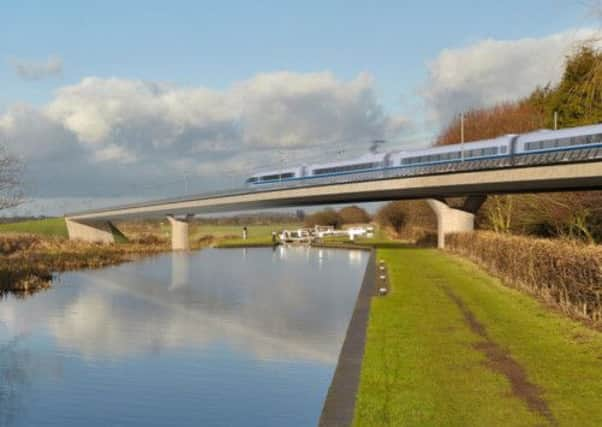Time to fast-track new UK rail strategy


The HS2 Preparation Bill which was passed in June by a large majority in the House of Commons paves the way for the £42 billion High Speed Line linking London, Birmingham, Manchester and Leeds.
The West Coast Main Line is the busiest intercity and rail freight route in Europe and is expected to run out of capacity by 2025. The proposed new HS2 line is the best way of providing relief for growing traffic on both the West Coast and East Coast Anglo-Scottish routes.
Advertisement
Hide AdAdvertisement
Hide AdEngland, birthplace of rail in the nineteenth century, may in the 21st century at last catch up with Japan, China and continental Europe, where new railway lines support speeds of 200 mph between many major cities. Even the Glorious Nation of Kazakhstan is now building a 1000 km high speed line.
But Scotland will not see rail journey times cut by much under the current HS2 plans. The new line from London is planned to go no further north than Wigan, less than half-way to Glasgow and Edinburgh. So while the London-Manchester train journey will be cut by almost half to only 68 minutes in 2033 when the new line opens, the fastest London-Edinburgh journey is predicted to fall by only 9 per cent, from 4 hours to 3 hours 38 minutes. This is unlikely to boost rail’s London-Scotland market share, currently only about 20 per cent, and will leave Anglo-Scottish travellers still very dependent on airlines at a time when commercial competition for landing slots at London airports, and EU environmental legislation, will adversely affect the future of short distance domestic flights.
To bring real benefits, plans for HS2 need to be extended to reach Scotland. The economic benefit to Scotland of a new “fast track” line across the Border has been estimated at £25 billion over 60 years by the Partnership Group for High Speed Rail convened by the Scottish Government. Inward investment, tourism and business competitiveness would all benefit from faster Anglo-Scottish rail links. Conversely, failure to connect Scotland to the evolving high speed rail network would magnify the disadvantage of our peripheral situation in the UK and Europe.
But there is opposition in southern England to HS2. Many Conservative MPs in Buckinghamshire oppose construction of the line, though Buckinghamshire commuters are to benefit from investment in their local rail commuter network, with a new East-West line linking Oxford and Milton Keynes due to be opened in 2017. But clearly they believe people in “the North” don’t need better transport links.
Some commentators in London also argue that expenditure on a national rail project like HS2, linking nine of the UK’s largest cities, may be overtaken by progress in communications technology. But advances in networking and personal communications tools facilitate collaborative working and are likely to actually increase the already strong growth in demand for rail travel. Boris Johnson is arguing, instead of HS2, for construction of a second cross-London “Crossrail 2” railway in addition to the 13-mile long £16 billion Crossrail tunnel currently being built under London.
Against this pressure to spend ever more money on infrastructure projects in London and the South-east, it is vital that the Scottish Government and transport authorities in the Midlands and North of England continue to advance the case for HS2. The Edinburgh-Glasgow High Speed Line, announced last year by Deputy First Minister Nicola Sturgeon, is a good start to introducing 21st century rail technology in Scotland, raising speeds well above the level of the 1970s. The new Edinburgh-Glasgow line is planned to form the first section of a Scottish “HS2-S” High Speed Line linking with HS2 in northern England. It should allow a modest reduction in Glasgow-London rail journey times from its opening in 2024.
Transport Scotland and the Department for Transport need to finalise the strategy and economic case for Anglo-Scottish High Speed Rail as quickly as possible, by mid-2014 at the latest. One issue is whether a west coast alignment should be chosen, extending the planned HS2 northwards from Wigan via Carlisle to Glasgow and Edinburgh, or whether the best option would be an east coast route from Leeds via Newcastle to Edinburgh and Glasgow. Links to north of the Central Belt also need to be considered. Previous studies by Network Rail concluded that a west coast route via Carlisle showed the best economic results. It might be difficult to sell an east coast route to west coast politicians as this would make Glasgow 30 minutes further than Edinburgh from London. On the other hand, an east coast route would also serve Newcastle.
But whatever route is selected, it is vital that a consensus is reached in Scotland and the north of England to strongly push the case for High Speed Rail. Otherwise London and the south-east will continue to soak up the lion’s share of transport investment and economic growth.
• Dr John McCormick is Chairman of the Scottish Association for Public Transport